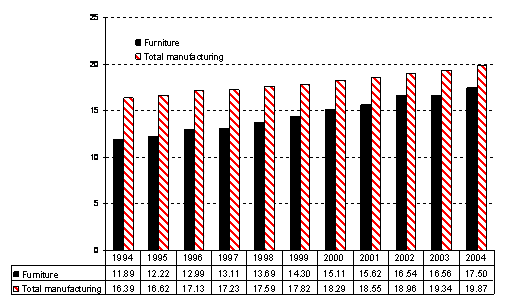|
FURNITURE
EMPLOYMENT BY INDUSTRY SEGMENT

When furniture employment is expressed as
a percentage of the provinces?overall manufacturing employment, Manitoba at 9.4% had the
largest portion of manufacturing employment devoted to furniture manufacturing.
Manitoba is followed by Quebec with 6.2% of total manufacturing employment, well above the
Canadian average of 5.1%.
The percentage in all other provinces is below the national average.
The average furniture firm in
Canada in 2004 employed 53 persons. ? By firm type the average number of employees ranges
from a high of 98 in the office furniture segment to a low of 31 ion the wooden household
furniture segment. The furniture industry is dominated by a very few giants and a large
number of very small companies. Well over three quarters of all establishments fall below
the average of 53 employees. Only some 13% of establishments have 100 employees or more.
The degree of employment concentration has changed somewhat during the past decade,
reflecting the industry's adaptation to increased economy of scale production.
?Since the early 1990s recession the furniture industry? real value added grew at a faster
pace than employment. So furniture productivity has been growing quickly, no doubt
propelled by a compelling need to use more labor saving technologies in today? competitive
environment
Increased automation and the adoption of new electronic and other processing technologies
will lead to a continuing shift from low skill to high skill occupations.
Shortages for skilled labor in the furniture industry persist to this day. The influx of
skilled European labor has dwindled to a trickle, and Canada is not yet producing the
required quantity and quality of skills from within its own ranks.
Between the early 80s and the early 90s there was the slight decline in real wages but
following the recession in the 90s, there was a modest reversal of that trend. Assuming
positive growth of the economy, real wages can be expected to continue to increase in the
years to come.? Furthermore, workers and managers will need more specialized skills, and
such workers can only be attracted by higher pay rates.
The aging of the population will also drive wages to higher levels.
The flow of young and relatively inexpensive workers will become less abundant.
As a result, industry will be forced to increasingly engage more mature workers, who are
invariably more expensive, but not necessarily more skilled, on modern machines.
All of which suggests training and will take on added significance in the furniture
industry over the decade ahead.
As of 2004 the average furniture industry production employee received $17.50 per hour
compared to $19.87 per worker in manufacturing in general.
Thus there is an 13.5% gap between the earnings of production workers in furniture and of
production workers in manufacturing generally. ?In 1994, however, the gap was actually
much wider at 37.9%, so a noticeable relative improvement in furniture production wage
rates has occurred.
Average hourly earnings in the household segment always lagged behind those of the office
furniture segment. ?
AVERAGE HOURLY EARNINGS OF MANUFACTURING AND FURNITURE MANUFACTURING PRODUCTION WORKERS,
1994 to 2004 IN $ 
For
more information click: http://furniture-info.com/117.htm
|